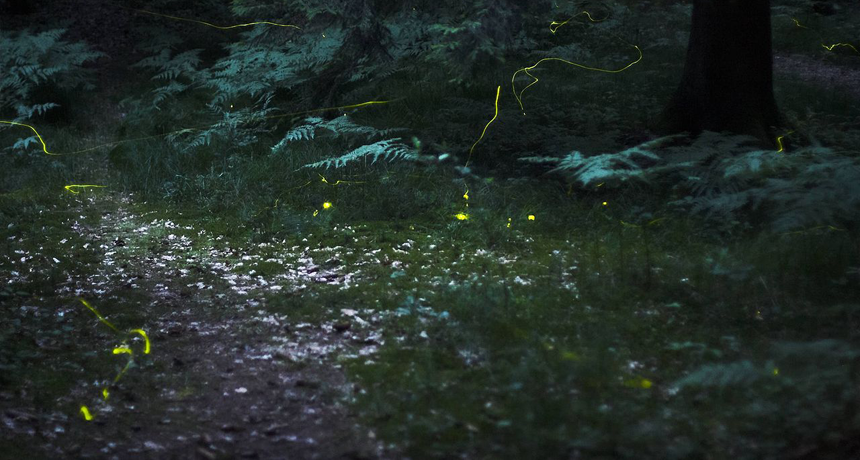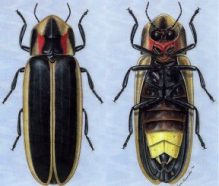Firefly delight
Decoding firefly flashes unveils mating signals and other secrets of insect life.

Fireflies light up the forest floor near Nuremburg, Germany.
Quit007 / Wikimedia Commons CC BY-SA 3.0
By Emily Sohn
Summer is a magical time. I love the vivid flowers, the brilliant sunsets, and, perhaps most amazing of all, the bright flashes of fireflies dancing in the night.
In my fascination with fireflies, I’m not alone.
 |
|
A firefly rests on white clover.
|
| iStockphoto.com |
“When kids see fireflies, they commonly ask one question: ‘Why do they light up?'” says entomologist Marc Branham of the University of Florida in Gainesville. “It’s the parents who ask: ‘How can fireflies actually produce light?'”
Scientists are shedding light on both questions.
And they have plenty of material to work with. Fireflies live on every continent except Antarctica. About 2,000 species are known to scientists, and many more probably remain to be discovered.
Different types of fireflies vary in how quickly they flash, how long the flashes last, and what color the flashes are.
“We’ve known for a long time that fireflies use different signals,” says Sara Lewis, an evolutionary ecologist at Tufts University in Medford, Mass. “Only in the past few years have we been able to decode some of the details of those flashes.”
Chemical light
Fireflies, deep-water fish, bacteria, and other organisms that produce their own light are said to be bioluminescent.
A firefly’s light is produced by a chemical reaction involving a special protein, a pigment called luciferin, and oxygen. The protein, named luciferase, acts as an enzyme, starting the chemical reaction that generates light.
 |
|
Light-producing chemical reactions in a firefly’s abdomen cause certain cells on its underside to glow (right). The species shown in this illustration is Say’s firefly, one of about 175 known species of fireflies in the United States.
|
| Scientific illustration by Arwin Provonsha, Purdue Department of Entomology |
Most bioluminescent creatures simply glow. The flash of the firefly sets it apart. “The ability to turn light on and off with precise timing is much more rare,” Lewis says.
To make light, she says, a firefly’s brain sends a signal to the light organ in its abdomen, where the light-producing chemical reactions occur. A few years ago, Lewis and her colleagues discovered that the process also involves a gas called nitric oxide. It’s this gas that operates the insect’s on-off switch.
Scientists have also uncovered the genetic information, contained in a firefly’s DNA, responsible for producing luciferase.
Such discoveries about firefly biology have been especially exciting to medical researchers. They can implant the firefly’s light-producing gene into cells inside other animals. Then, by monitoring the glow, they can track those cells in the animals’ bodies.
 |
|
These fruit flies contain some firefly DNA, which enables them to glow in the dark.
|
| Steve A. Kay, Scripps Research Institute |
By making cancer cells glow, for example, researchers can trace the effectiveness of a treatment. If all the glowing cells disappear, it’s a sign that the treatment may be working.
Mating signals
Other scientists are examining why fireflies flash. So far, it appears that fireflies flash for two reasons: to attract mates and to attract prey.
But not just any type of flash will do. One recent study found that in some firefly species, females prefer to mate with males whose flashes last the longest. In other species, females prefer males who flash the fastest.
Individual differences in flash length and speed are so slight that our eyes can’t detect them. But special instruments can detect the differences—and so can fireflies. Scientists can test this by flashing precise light patterns of their own and observing which ones female flies respond to by flashing in turn.
 |
|
The firefly is a type of beetle. Found in New York State, this example is one of about 2,000 firefly species known worldwide.
|
| © 2004 Joyce Gross |
A closer look suggests why the ladies care how their men flash. Often, males that have the best chance of fathering lots of young also flash fastest or longest, Lewis’ group has found. So, it makes sense for females to pick the “flashiest” males.
Such studies give insights into the process of sexual selection, which describes how choosing mates helps drive evolution.
A firefly’s flash is similar to a cricket’s chirps and other types of animal mating signals. “It’s helpful to compare multiple types of signals across a lot of organisms to see if they evolved the same way because they’re obviously not produced the same way,” Branham says.
“We’ve found time and time again that lots of organisms arrive at the same answer by different routes,” he adds. “When we compare these patterns, it can tell us a lot about how life converges on the same solutions to the same problems.”
Declining numbers
Studying fireflies could also help protect them. No one has counted fireflies from year to year, but some experts worry that their numbers are declining.
 |
|
A boy traps fireflies at twilight.
|
| iStockphoto.com |
“Every summer, a lot of people ask me why there are fewer fireflies out there than when they were kids,” Branham says. “I think when people realize there’s stuff to learn about fireflies in addition to the fact that they’re fun to watch and catch, maybe conservation will take a higher profile.”
You’d have to get over any fear of the dark that you might have if you want to be a firefly scientist. To observe them, you need to spend time outside at night. And if you turn on your flashlight, the fireflies shut off theirs.
Branham does much of his research in rain forests, and the work can be creepy.
“In tropical areas, there are a lot of poisonous snakes that are nocturnal,” he says. “Combine that with the necessity of not turning on your flashlight, and it’s a pretty intense experience.”
Still, the more you study fireflies, the more amazing they get, Lewis says.
“Learning about them enhances the mystery,” she says. “I’m still completely blown away by the fact that they’re doing this.”
Going Deeper:







